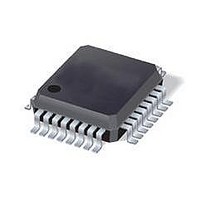ST7FLITE49K2T6 STMicroelectronics, ST7FLITE49K2T6 Datasheet - Page 164

ST7FLITE49K2T6
Manufacturer Part Number
ST7FLITE49K2T6
Description
IC MCU 8BIT 8K FLASH 32LQFP
Manufacturer
STMicroelectronics
Series
ST7r
Datasheet
1.ST7FLITE49K2T6TR.pdf
(245 pages)
Specifications of ST7FLITE49K2T6
Core Processor
ST7
Core Size
8-Bit
Speed
8MHz
Connectivity
I²C, SPI
Peripherals
LVD, POR, PWM, WDT
Number Of I /o
24
Program Memory Size
8KB (8K x 8)
Program Memory Type
FLASH
Eeprom Size
256 x 8
Ram Size
384 x 8
Voltage - Supply (vcc/vdd)
2.4 V ~ 5.5 V
Data Converters
A/D 10x10b
Oscillator Type
Internal
Operating Temperature
-40°C ~ 85°C
Package / Case
32-LQFP
Processor Series
ST7FLITE4x
Core
ST7
Data Bus Width
8 bit
Data Ram Size
384 B
Interface Type
I2C, SPI
Maximum Clock Frequency
8 MHz
Number Of Programmable I/os
24
Number Of Timers
4
Maximum Operating Temperature
+ 85 C
Mounting Style
SMD/SMT
Development Tools By Supplier
ST7FLITE-SK/RAIS, ST7FLI49M-D/RAIS, STX-RLINK
Minimum Operating Temperature
- 40 C
On-chip Adc
10 bit, 10 Channel
For Use With
497-8399 - BOARD EVAL ST7LITE49M/STLED316S497-5858 - EVAL BOARD PLAYBACK ST7FLITE
Lead Free Status / RoHS Status
Lead free / RoHS Compliant
Available stocks
Company
Part Number
Manufacturer
Quantity
Price
Company:
Part Number:
ST7FLITE49K2T6
Manufacturer:
ST
Quantity:
3 000
Company:
Part Number:
ST7FLITE49K2T6
Manufacturer:
STMicroelectronics
Quantity:
10 000
Company:
Part Number:
ST7FLITE49K2T6TR
Manufacturer:
STMicroelectronics
Quantity:
10 000
On-chip peripherals
Note:
164/245
Figure 78. Clearing the WCOL bit (write collision flag) software sequence
Single master and multimaster configurations
There are two types of SPI systems:
●
●
Single Master System
A typical single master system may be configured using a device as the master and four
devices as slaves (see
The master device selects the individual slave devices by using four pins of a parallel port to
control the four SS pins of the slave devices.
The SS pins are pulled high during reset since the master device ports will be forced to be
inputs at that time, thus disabling the slave devices.
To prevent a bus conflict on the MISO line, the master allows only one active slave device
during a transmission.
For more security, the slave device may respond to the master with the received data byte.
Then the master will receive the previous byte back from the slave device if all MISO and
MOSI pins are connected and the slave has not written to its SPIDR register.
Other transmission security methods can use ports for handshake lines or data bytes with
command fields.
Multimaster system
A multimaster system may also be configured by the user. Transfer of master control could
be implemented using a handshake method through the I/O ports or by an exchange of
code messages through the serial peripheral interface system.
The multimaster system is principally handled by the MSTR bit in the SPICR register and
the MODF bit in the SPICSR register.
1st Step
2nd Step
Single Master System
Multimaster System
Clearing sequence after SPIF = 1 (end of a data byte transfer)
Clearing sequence before SPIF = 1 (during a data byte transfer)
1st Step
2nd Step
Read SPICSR
Read SPIDR
Figure
RESULT
SPIF = 0
WCOL = 0
Read SPIDR
79).
Read SPICSR
RESULT
WCOL = 0
Note: Writing to the SPIDR register
instead of reading it does not reset
the WCOL bit
ST7LITE49K2














